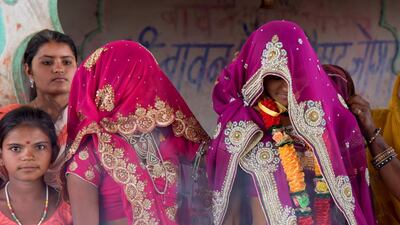India has near halved its rate of child marriage over the past decade, UN data has showed, with public awareness campaigns and better access to education being credited.
At present, 12 million girls around the world are wedded every year, with an eighth of those girls living in India where the legal age for marriage is 18 for women and 21 for men.
But enforcing the law has proven difficult in a country with a population of more than 1.3 billion, spread across a vast land mass.
The new figures from UNICEF, however, show a decline in underage girls getting married - from 47 percent in 2006 to 27 percent in 2016, the most recent year for which statistics were available.
The parents of underage brides and grooms in India, if caught, face two years in prison and 100,000 rupees in fines. Further, India’s Supreme Court ruled last year that any men reported for indulging in sexual relations with underage wives were liable to be prosecuted for rape.
Anju Malhotra, a gender adviser with UNICEF, attributed the falling child marriage rate on greater numbers of girls attending school as well as more awareness through the internet about the drawbacks of child marriage.
In 2006, according to figures from Pratham, a non-profit that conducts an annual education survey, roughly 89 per cent of Indian girls enrolled in primary school at the age of six. By 2016, that figure had risen to 95 percent.
___________________
Driving with Selvi: documentary follows the life of a former child bride for a decade
India Supreme Court stops centuries-old councils from meddling in marriages
___________________
Girls still tend to drop out of school in large numbers, however, particularly around the age of 14 or 15. But these numbers are dipping as well. In 2004, government data shows, 64 per cent of girls had left school by the time they reached 15. By 2012 — the last year for which the government website lists comparative statistics — the proportion had come down to 52 per cent.
The government has also been more vocal about cracking down on child marriage, which is still seen, in many parts of the country, as acceptable, though the number of cases formally registered against parents under the law criminalising child marriage is still a drop in the bucket: 326 in 2016.
Arrests and punitive sentences are rare but they do occur. In 2016 police arrested the 35-year-old husband of a 10-year-old bride, as well as five people who helped arrange the wedding.
Enforcing the law remains difficult, said Kriti Bharti, who runs the Saarthi Trust, a Jodhpur-based non-profit that works to annul child marriages.
The marriages are often conducted in villages, solemnised under religious rites; they may never be formally registered, and local authorities may be complicit in permitting them to take place.
If no one comes forward to report the marriage, the cases slip under the state’s radar, Ms Bharti said.
"The girls involved here are children, after all," she said. "They don't really know if they're being abused or exploited. They can't speak up for themselves."
The girls also want to avoid disobeying their parents. "One of the girls whose marriage we helped to annul said that she had first told her mother about how she did not want to be married," she said. "Her mother told her, 'You have to bear this. It's our destiny.'"
Gradually, though, as awareness about the law has spread, Ms Bharti has seen more and more girls approach her and her team, asking for help to get their marriages annulled. "They used to be very shy about it. But now they tend to get motivation from each other," she said.
Last October, in a much-publicised case, Ms Bharti helped Sudipta Bishnoi, a 19-year-old woman, annul her marriage. She and her husband married when both were 12 years old. Ms Bishnoi left him when he became an alcoholic.
"It was about life and death. And I chose to live," she told reporters at the time.
Globally, a decade ago, one girl in four was getting married before the age of 18. That proportion has now dropped to one in five, said the UNICEF data. The past 10 years saw 25 million fewer child marriages than might have been expected under the rate a decade ago, according to the figures.
Among the UN's Sustainable Development Goals is to end child marriages by 2030. For that to happen, progress has to happen even faster than it has over the past decade.

